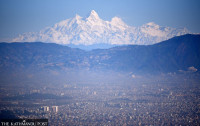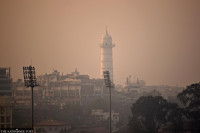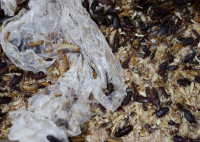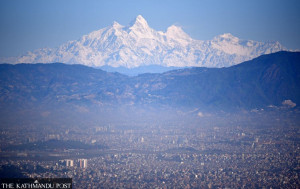Climate & Environment
Nothing is being done to curb local pollution, environmentalists say
Vehicle emissions, industries, brick kilns and construction are major sources of air pollution.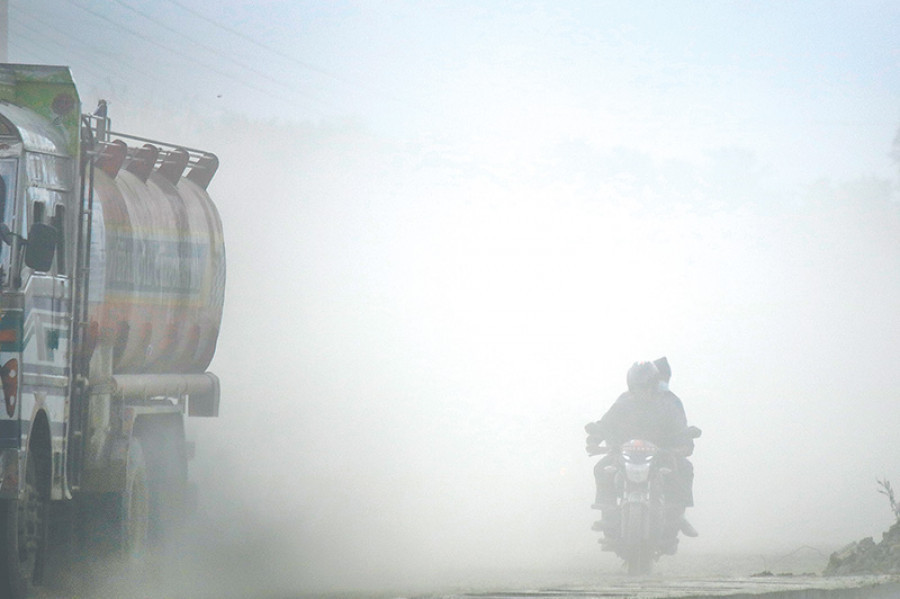
Chandan Kumar Mandal
Kathmandu and other parts of the country have been enveloped in toxic air for the past week emanating from dozens of wildfires around Nepal, and the general public has been gasping for clean and fresh air.
While controlling all the fires anytime sooner, because of its intensity and lack of mechanism, looks like an uphill task, experts prioritise implementing measures, including declaring a public health emergency, to help reduce local emissions to bring down pollution levels, especially in cities.
However, authorities have not only refrained from taking tough action against local sources of pollution, they have also not declared a public health emergency as per a government plan to deal with high levels of air pollution prepared earlier.
“Locally-generated pollution also causes harm. Forest fires and cross-border pollution only intensify local pollution,” said Manjeet Dhakal, an environmentalist and a climate change expert stressing the importance of curbing local pollution.
Emissions from vehicles, industries, brick kilns, burning of waste, and construction are the major sources of air pollution in Kathmandu Valley. But despite soaring levels of pollution, nothing much is being done to curb the generation of pollutants from these sources to address the problem as authorities blame the deteriorating air quality on forest fires, which are beyond their control.
Since Friday last week, various parts of the country, including Kathmandu Valley, remain blanketed in hazardous smoke that emanated from wildfires across the country. The capital city, at 1:45 pm on Wednesday afternoon, topped the list of the most polluted cities in the world. Since Friday, air quality monitoring in different parts of the Kathmandu Valley has crossed the AQI level of 300 marks many times.
As the air quality has continued to plummet, various authorities, mainly the Department of Environment and Ministry of Health, issued health advisories urging the public to remain indoors and avoid outdoor activities, unless absolutely necessary. However, they have refrained from declaring a health emergency.
“As far as declaring a public health emergency is considered, the government’s own decision says that if the AQI level reaches 300, then a public health emergency is to be declared,” said Bhushan Tuladhar, another environmentalist who closely follows urban environmental issues, including air pollution. “Therefore, according to the government action plan, we are already in an air pollution emergency.”
The Kathmandu Valley’s Air Pollution Management Action Plan Tuladhar referred to was endorsed by the Cabinet last year. It says that authorities can declare a public health emergency whenever AQI readings exceed 300.
The Phora Durbar air quality monitoring station has recorded over 300 AQI four times since Friday, with the highest, 352, recorded on Saturday.
Even in January, when air quality had severely deteriorated in the Valley, crossing the AQI level of 300, authorities had not announced an emergency.
“This is true for most rules, strategies, action plans and policies that the government prepares. Most of it is limited to paper,” said Tuladhar.
However, officials deny that such plans even exist. “There aren’t any provisions that call for declaring a health emergency,” said Indu Bikram Joshi, a spokesperson for the Department of Environment. “Once the AQI goes over 300, we need to take actions such as issue public notice about pollution and shut down schools, both of which we have done. There is no need to declare an emergency as doing so will only create havoc.”
Tuladhar pointed out that shutting down schools barely helps in the fight against air pollution.“Closing schools won’t bring down pollution levels as pollution from other sources continues unabated. Rather, play outside in polluted air when they are given a holiday,” said Tuladhar.
Joshi, also the deputy director-general of the department, said if ongoing initiatives are not adequate to bring down pollution levels, then more actions such as limiting vehicular movement, will be taken.
But the government should have already taken such actions, according to the plan. It says that while open burning of waste needs to be banned, roads need to be cleaned with broomer vehicles, and public notices issued to ask people to wear N95 masks. The plan also says that people need to be advised to avoid unnecessary outdoor activities, keep elderly and children safe and stop operating vehicles.
Likewise, the plan calls for a ban on the entry of goods-carrying trucks and shutting down of industries inside the Valley.
“The air quality action plan envisions a coordination committee headed by the environment minister. I don’t know if the coordination committee has even convened,” said Tuladhar.
The government official Joshi, however, said as current pollution is mostly because of wildfire, the department of the environment can’t do anything about it.
“Controlling wildfires is beyond our jurisdiction. Other agencies are already doing it and the pollution level has come down slightly today [on Wednesday],” said Joshi. “For cutting down long-term emissions, we have been working on strategies to import better quality fuels and reduce pollution from brick kilns. Enforcing odd-even rules for vehicles is also one of the measures that can be implemented if required.”
But experts such as Dhakal are not convinced. “Authorities can’t shrug their responsibilities by saying that nothing can be done about the pollution from wildfires,” said Dhakal. “The government has collected nearly Rs12 billion in pollution taxes which remain unutilised,” said Dhakal.
“We have been spending billions on buying one fossil fuel, which only adds to the pollution problem,” he told the Post. “Over the years, we haven’t worked towards cutting down the consumption of fossil fuel, but walked in the opposite direction, constructing pipelines and shifting our focus from domestic sources of pollution.”




 10.12°C Kathmandu
10.12°C Kathmandu
